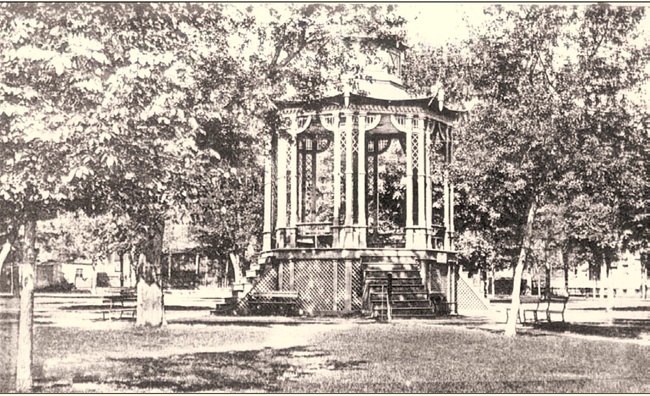
Jackson Park, originally known as Jackson Square, wasn’t always a public park. Located between Main, Iowa, 15th, and 17th Streets, the northern part of today’s park was once the site of Dubuque’s first designated cemetery. In late 1833, a cholera epidemic began claiming the lives of early settlers, and the city officials opened burial plots “at the edge of town” and away from the log homes of the city residents. Just a few years later in 1837, there were already problems. First, the cemetery conflicted with the construction of new city streets as the town began to spread toward the north. Second, citizens living nearby didn’t like the idea of a cemetery so close to their homes.
By 1851, the city council prohibited new graves in the old cemetery. The city soon purchased ten acres northeast of the city for burials – acres that would come to be known as Linwood Cemetery. In 1856, the city council published a notice in the newspaper instructing all those having family and friends buried in the old cemetery to remove them. In 1858, tombstones and most of the remaining graves from the old cemetery were moved to Linwood Cemetery.
Unfortunately, some graves were left behind in the old cemetery, and as late as 1868, skeletons began appearing following heavy rain falls and young boys were chided for playing “skinny” with the bones. In 1869, the city finally stepped in and hired William Rebman to grade, level, and plant trees in the area of the former cemetery.
The Dubuque Herald announced in 1873 that “the city fathers intend to make this plot [Jackson Park] of ground one of the beauty spots of the city.” A few years later in 1877, the city hired architects Heer and Naescher to build a gazebo in the new park. The $150 project was funded by ten citizens and dedicated by Congressman David B. Henderson in September. The design of the gazebo was questionable with steep stairs and no hand railings. Republican candidate James G. Blaine refused to use the space as a setting for a late 1878 speech, preferring to speak from an A.A. Cooper wagon. The gazebo was torn down and sold for scrap just twenty years later as it had been so neglected that it had become a dangerous eyesore. Jackson Square was a public park in name only. It was fenced and was unavailable for general public use in its early years. Boys used the vacant lot north of the square for a ball ground and sometimes ran into the square after a batted ball. The pagoda was only available for band use. Sitting in it was forbidden. The police were called to arrest any person trespassing on the square. The July 17, 1879, Herald called upon the city “to open Jackson Park to the public.”
To read the remainder of this premium article and other premium articles in their entirety, pick up the Julien’s Journal October 2025 issue. Single issues are available in print for free at area newsstands, or you can click here to read the entire article for free in the digital version of the magazine.
Read Julien’s Journal, CHOICES For Fifty Plus and Tri-State Home TRENDS from the Comfort of Your Home!
Click to subscribe or call 563.557.7571 to subscribe for convenient delivery to your home or business by mail.


Comment here